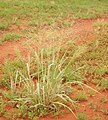The Agriculture Portal

Agriculture encompasses crop and livestock production, aquaculture, and forestry for food and non-food products. Agriculture was a key factor in the rise of sedentary human civilization, whereby farming of domesticated species created food surpluses that enabled people to live in the cities. While humans started gathering grains at least 105,000 years ago, nascent farmers only began planting them around 11,500 years ago. Sheep, goats, pigs, and cattle were domesticated around 10,000 years ago. Plants were independently cultivated in at least 11 regions of the world. In the 20th century, industrial agriculture based on large-scale monocultures came to dominate agricultural output.
As of 2021[update], small farms produce about one-third of the world's food, but large farms are prevalent. The largest 1% of farms in the world are greater than 50 hectares (120 acres) and operate more than 70% of the world's farmland. Nearly 40% of agricultural land is found on farms larger than 1,000 hectares (2,500 acres). However, five of every six farms in the world consist of fewer than 2 hectares (4.9 acres), and take up only around 12% of all agricultural land. Farms and farming greatly influence rural economics and greatly shape rural society, affecting both the direct agricultural workforce and broader businesses that support the farms and farming populations.
The major agricultural products can be broadly grouped into foods, fibers, fuels, and raw materials (such as rubber). Food classes include cereals (grains), vegetables, fruits, cooking oils, meat, milk, eggs, and fungi. Global agricultural production amounts to approximately 11 billion tonnes of food, 32 million tonnes of natural fibers and 4 billion m3 of wood. However, around 14% of the world's food is lost from production before reaching the retail level.
Modern agronomy, plant breeding, agrochemicals such as pesticides and fertilizers, and technological developments have sharply increased crop yields, but also contributed to ecological and environmental damage. Selective breeding and modern practices in animal husbandry have similarly increased the output of meat, but have raised concerns about animal welfare and environmental damage. Environmental issues include contributions to climate change, depletion of aquifers, deforestation, antibiotic resistance, and other agricultural pollution. Agriculture is both a cause of and sensitive to environmental degradation, such as biodiversity loss, desertification, soil degradation, and climate change, all of which can cause decreases in crop yield. Genetically modified organisms are widely used, although some countries ban them. (Full article...)
Selected article
However, despite immense land resources, extensive machinery and chemical industries, and a large rural work force, Soviet agriculture was relatively unproductive, hampered in many areas by the climate (only 10 percent of the Soviet Union's land was arable), and poor worker productivity. Conditions were best in the temperate black earth belt stretching from Ukraine through southern Russia into the west, spanning the extreme southern portions of Siberia.
Stalin's campaign of forced collectivization was a major factor explaining the sector's poor performance. Collectivization relied on a system of internal passports to keep farmers tied to the land. This has been referred to as a form of "neo-serfdom", in which the Communist bureaucracy replaced the former landowners. The first response of most farmers to this loss of freedom was to slaughter and consume their farm animals. In the new state and collective farms, outside directives failed to take local growing conditions into account. Also, interference in the day-to-day affairs of peasant life often bred resentment and worker alienation across the countryside. The human toll was very large with millions, perhaps as many as 3 million, dying from famine in the wake of collectivisation. In the collective and state farms, low labor productivity was a consequence for the entire Soviet period.
The claims of inefficiency have, however, been criticized by Economist Joseph E. Medley of the University of Southern Maine, US. Statistics based on value rather than volume of production may give one view of reality, as public-sector food was heavily subsidized and sold at much lower prices than private-sector produce. In addition, the 2–3% of arable land allotted as private plots does not include the large area allocated to the peasants as pasturage for their private livestock; combined with land used to produce grain for fodder, the pasturage and the private plots total almost 20% of all Soviet farmland. Private farming may also be relatively inefficient, taking roughly 40% of all agricultural labor to produce only 26% of all output by value. Another problem is these criticisms tend to discuss only a small number of consumer products and do not take into account the fact that the kolkhozy and sovkhozy produced mainly grain, cotton, flax, forage, seed, and other non-consumer goods with a relatively low value per unit area. This economist admits to some inefficiency in Soviet agriculture, but claims that the failure reported by most Western experts would only be a myth. (Full article...)
Selected image

Did you know...
General images
Related portals
Topics
Categories
Things you can do
- – When a task is completed, please remove it from the list.
WikiProjects
Associated Wikimedia
The following Wikimedia Foundation sister projects provide more on this subject:
-
Commons
Free media repository -
Wikibooks
Free textbooks and manuals -
Wikidata
Free knowledge base -
Wikinews
Free-content news -
Wikiquote
Collection of quotations -
Wikisource
Free-content library -
Wikiversity
Free learning tools -
Wiktionary
Dictionary and thesaurus
Agriculture journals

- Agronomy Journal - the American Society of Agronomy
- Agronomy for Sustainable Development Journal
- European Journal of Agronomy
- Journal of Agronomy and Crop Science
- Journal of Organic Systems
- Agriculture, Ecosystems & Environment
- Agriculture and Human Values
- Computers and Electronics in Agriculture
- Precision Agriculture
- Experimental Agriculture
- Journal of Integrative Agriculture
- Journal of the Science of Food and Agriculture
- Renewable Agriculture and Food Systems
- Biological Agriculture & Horticulture
See also:



































































